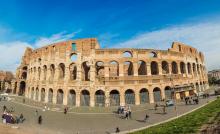Constantine

ALMOST HALF OF Americans believe the United States should be a “Christian nation,” according to a survey this fall, and a significant percentage say that the Bible should have more sway than the will of the people in shaping U.S. laws when the two conflict. The opinions expressed in the October survey by the Pew Research Center break along party lines, with three-quarters of Republicans (and less than half of Democrats) saying the founders intended for the country to be a Christian nation, and 4 in 10 Republicans (compared to 16 percent of Democrats) believing that the Bible, rather than majority rule, should be the source of the nation’s laws. (A similar percentage of Republicans — 39 percent — surveyed by the American Enterprise Institute in 2021 said that political violence may be necessary to “protect America.”) This summer, Republican Rep. Marjorie Taylor Greene declared that “We need to be the party of nationalism, and I’m a Christian, and I say it proudly, we should be Christian nationalists.”
While it may seem that a portion of one of the country’s two main parties has wandered off to never-never land, the survey doesn’t mean the country is heading toward theocracy—yet. Most of the respondents who say the U.S. should be a Christian nation, according to Pew, “are thinking of some definition of the term other than a government-imposed theocracy.” (A small minority, in the words of one respondent, view Christian nationalism as a way “to use the government to impose an extreme, fringe version of Christianity on everyone in the nation, regardless of others’ religious views. They are no different than al-Qaida or the Taliban.”)

Last week I spent a few days in Rome with, among others, Tony Jones. As someone who hasn’t ever been to Rome, it was particularly helpful for me to have a Christian historian along. It’s easy enough, having seen one amazing display of ruins after another, or cathedral after awesome cathedral, to lose some perspective. So along the way, Tony would stop and point out the historic significance of various landmarks. Then of course, we’d go grab a bourbon and talk.
Both of us, at one point or another in the week, thought of the Monty Python scene from Life of Brian, in which the disgruntled rebels exclaim, “What have the Romans ever done for us?” So of course, some wise guy in the group starts rattling things off, like the aqueducts, roads, education, and so on.
So this led to a minor debate between Tony and me about the benefits of empire. Now, keep in mind that Tony is never one to pass up an opportunity to serve as the antagonist, but his argument as outlined in his blog post cheekily titled “In Praise of Empires,” is that it’s en vogue to trash empire, both present and past.
To put a finer point on it, we chatted about whether Constantine, the Roman emperor responsible for establishing the Nicene Creed, was an ass-hat.
![St. Peter in Prison (The Apostle Peter Kneeling). Photo courtesy Rembrandt [Public domain], via Wikimedia Commons/RNS](https://sojo.net/files/styles/medium/public/blog/Rembrandt_st._peter_in_prision.jpg)
When Pope Francis cradled the small box said to contain nine bone fragments believed to be the mortal remains of St. Peter, the first pope, he fanned the flames of a long-standing debate over the authenticity of ancient church relics.
Most old churches in Italy contain some ancient relic, ranging from a glass tube said to hold the blood of St. Gennaro in Naples to a section of what is believed to be Jesus’ umbilical cord in the Basilica of St. John of Lateran in Rome. Perhaps the most famous religious relic in Italy — the Shroud of Turin, believed by many to be Jesus’ burial cloth — will go on display again in early 2015, and Turin Archbishop Cesare Nosiglia this week invited Pope Francis to attend its public debut.
But St. Peter’s bones are of particular importance, since they are the very basis — both architecturally and spiritually — for Catholicism’s most important church. And yet the bones were only discovered during a series of excavations in the 1940s, almost 1,900 years after Peter died, in either 64 or 67 A.D.